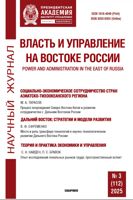CONTENTS
No.2, 2020
< briefly >
| № | Authors |
Article name |
File |
|---|---|---|---|
The Far East:nev strategies and development models | |||
| 1 | O. G. Ivanchenko A. N. Grigorieva E. S. Ivanchenko |
The impact of credit resources in the development industry of the Far-Eastern regions of Russia | |
In the period of 2000-2018, the Russian economy experienced several external shocks (crisis periods): in 2004, 2008, and 2014, which had a significant impact on credit support for the production and investment sectors. Industrial enterprises in the Russian Federation maintained their share in the structure of the economy throughout the observation period, while the share of industry in the GRP structure of a separate region of the Far-Eastern federal district – the Khabarovsk territory decreased by more than 2 times. Maintaining the position of Russian industry was accompanied by an increased dependence of production and investment activities on the credit resources. In the economy of the Khabarovsk territory, there was a decrease in investment. The minimum growth rate of investment in the fixed capital compared to the previous year in the region was observed in the post-crisis year 2005, and in 2012–2017, investment declined annually. One of the reasons for the reduction in investment was a decrease in the share of credits in the sources of investment financing. At the same time, the role of banks was not stable and significantly fluctuated under the influence of crisis events. The level of the share of Bank loans in the sources of investment financing less than 5% was formed in the Khabarovsk territory in 2004, 2010, 2017, while the lowest indicator (3.3%) in 2010 corresponded to the lowest share of the region's industry in the structure of investment into the fixed capital (19%).
Keywords: industry, sources of financing investments in fixed assets, lending. | |||
| 2 | S. N. Naiden M. A. Gritsko N. S. Burevaya |
Social infrastructure development as a condition of human capital growth | |
Sustainable development of the society implies the presence of highly developed human capital, the necessary condition for the growth of which is the creation and maintenance of a decent quality of life, providing a modern and accessible social infrastructure for all segments of the population. One of the limitations of solving this problem is the objective uneven spatial distribution of economic and social resources throughout the country, which is most used in the regions of the Far East, which are characterized by a high differentiation of living standards and experiencing an outflow of the population. The search for an objective connection between the indicators characterizing the development of social infrastructure and the growth of human capital, as well as its adequate assessment, are the goal of this article. The article discusses the features of prevailing distribution of the population and human potential among the subjects of the Far-Eastern federal district. The statistical materials in the Khabarovsk territory analyze the dynamics and components of the Human Development Index, which is officially calculated by the Analytical Center under the Government of the Russian Federation. It was revealed that the reason for the lag of HDI in the region from the national average is associated with the low indicators of life expectancy. Based on the standard methodology using the index approach, an assessment is made of the relationship between the level of development of social infrastructure and the human capital index, as well as the human development index. As a result of the study, it was found that between the dynamics of human capital development and the level of development of the social infrastructure of the Khabarovsk territory there is a direct moderate link, supported to a greater extent by investments in the education infrastructure and, to a lesser extent, by healthcare. The limited substantive interpretation of the estimates obtained at the regional level is justified, which requires additional disaggregation and comparative comparisons at the municipal level.
Keywords: human capital, human potential, human development index, social infrastructure, the Far East. | |||
Social and economic cooperation of the countries of the Pacific Rim
| |||
| 3 | V. Yu. Ambrutis N. M. Shum |
Strategic management of increasing the export efficiency of timber products of the Far East to the countries of Northeast Asia | |
Currently, an unfavorable situation is developing for the forest complex of the Far East regarding the possibilities of its extensive development. Due to the remoteness of large domestic consumers of forest products, the main solvent market for the forest complex of the Far East are the countries of North-East Asia, and therefore there is a threat of a strategic dependence of the forest industry of the Far East on the economic situation in these countries and the global economy as a whole , which, combined with the changing structure and volume of global and regional demand for forest products, requires an increase in the efficiency of export of timber products from the Far East. The use of strategic management tools will make it possible to increase not only the export efficiency of timber products of the Far East to the countries of the Northeast Asia, but also the competitiveness of the entire timber industry of the Far East.
Keywords: forest industry, economic interaction, the Far East, countries of the Northeast Asia, export, strategic management. | |||
| 4 | Tzou Syutin | Impact of the coronavirus epidemic on the China's economy and the government and regional countermeasures | |
Coronavirus epidemic that began in early 2020 in several regions of China has become a powerful destabilizer of the country's economy. The spread of this infection has especially affected the activities of consumer and service industries, which make a relatively high share in the structure of the Chinese national economy. In 2019, the share of final consumption spending in the country's economy reached 57.8%. In order to reduce the negative impact of epidemic on the economy, especially to prevent difficulties in the work of small and medium-sized enterprises, the Chinese government, as well as the provincial and city authorities, quickly adopted a number of measures: banking, financial, tax and others. Thanks to these efforts, the economic losses from the epidemic were minimized and the trends in the long-term development of the Chinese economy were maintained.
Keywords: China, Heilongjiang, coronavirus epidemic, economic losses, government and regional support programs. | |||
Theory and practice of economics and management
| |||
| 5 | G. V. Tsvetova | Digital Economy: benefits, threats, and the influences factors | |
This article examines the impact of digital instruments on the economic and social development of the state; an overview of the benefits and threats of the digital economy; the conclusion was made about the accelerated development of the digital economy in a pandemic. The advantages of development of the digital economy include increasing the availability of various services, the emergence of new opportunities for training and mastering new types of professional activities, the creation and maintenance of the safe and comfortable conditions for human life. The threats to the digital economy are related to the reduction of medium-skill jobs through the release of personnel, the difficulties of using digital tools due to the low level of digital literacy of the citizens, financial fraud. The development of digital economy is influenced by the factors such as the demand for digital technologies; the emergence of innovative technologies; personnel potential; state regulation; Financial resources for the development and implementation of digital technologies. To overcome the threats of the digital economy, it is necessary to implement joint efforts of the authorities at different levels, educational organizations and employers in solving not only financial problems, but also ensuring that the infrastructure of the digital economy meets its personnel needs.tion and housing. Due to the strengthening of the fight against terrorism, the highest growth rate was observed in the group of expenditures on national security and law enforcement. Due to lagging revenue growth rates from the growth rate of budget expenditures in Birobidzhan, there is a systematic budget deficit and an increase in municipal debt. The municipal unit, unable to refuse to fulfill its social obligations, is objectively forced to increase the level of unproductive debt load using loans from commercial credit organizations in the conditions of low budget security and chronic deficit of the municipal budget. The article highlights the factors of instability of the studied MU and identifies budget risks that limit its budget stability, and determines the main directions for improving the budget stability at the municipal level.
Keywords: digital economy, digital technologies, demand, consumers, economic security. | |||
| 6 | I. A. Dokukina A. V. Polyanin V. V. Tarnovskiy |
Basic directions of improving the distribution of organizational tasks in the conditions of public management | |
The relevance of this study is expressed in the fact that the study of any organizational task allows us solve the problem in a complex, and therefore more competent way. Moreover, the analysis of social structure of the labor collective helps prevent future problems. The problem of distribution of organizational tasks is quite acute for all fields of activity. It must be recognized that employees are the same resource of the organization, as, for example, the raw materials, but have a number of features. They can show independent activity, they have their own desires, their own motivation. Employees perceive all management attempts through their own needs, in contrast to the technology, which simply needs to set the right program, and therefore they may not meet the expectations of management. There is also such problem as the “human factor” - people get tired, are guided, first of all, by their interests and do not always control what happens in front of their workplace. Among the other things, managers and specialists of the personnel service are also people, in connection with which misunderstandings may arise. Both at the level of the country and regions, and at the level of institutions, the need to activate and develop a social resource has become more and more obvious in recent times, which determines the relevance of research on the organizational component in public administration. The aim of the study is to develop a concept that includes the elements of sociological support for the processes of distribution of organizational tasks, the introduction of which will improve the effectiveness of personnel management.
Keywords: public administration, personnel, tasks, managerial decision, development, organizational tasks. | |||
| 7 | S. I. Zakharov | Assessing opportunities of competitiveness increasing in the coal industry enterprises | |
The relevance of the topic of this article is due to the growing discrepancy between the actual results of activities of senior employees and those required to ensure the trajectory of sustainable economic development of the Russian coal industry enterprises. The purpose of the article is to assess the possibilities and justify the priority areas of increasing the competitiveness of senior employees of the Russian coal industry enterprises in the modern conditions. The article justifies the criterion for assessing the competitiveness of senior employees of the coal mining enterprise – the ratio of value and price of labor results. The results of the head's work at the coal mining enterprise are proposed to be evaluated in the social and economic aspects in relation to the world industry leaders. Described approach to the competitiveness evaluation allows distinguish four characteristic competitive positions of managers in the coal mining enterprise: leadership, pursuit of leader, retention. An example and results of implementation of the proposed approach to assessment of opportunities to increase the competitiveness of senior employees of the Russian coal mining enterprises and the company are given. Based on the obtained quantitative data and ratios, it was concluded that there are significant opportunities to increase the socio-economic results of managers' work, and, therefore, their level of competitiveness and stability of functioning of the Russian coal industry enterprises. The work uses the methods of systemic, semantic, retrospective and the ABC analysis, as well as modeling and technical and economic calculations and benchmarking.
Keywords: executive, competitiveness of the worker, evaluation of possibility of increase in efficiency, coal-mining enterprise, value, added value, labor relations, social and economic system. | |||
| 8 | V. A. Tsibikov | Suicide prevention as a federal system (on the example of the Far-Eastern federal district regions) | |
The article reflects the results of the analysis of the system of work of public authorities and local authorities on suicide prevention among the population. The official statistics for 2010-2018 are summarized, which shows that there is a general downward trend in the number of suicides in the country. The features of the socio-economic situation in 2017-2020 are considered in the context of its impact on the suicide rate in some regions of the Far East. The legal and regulatory framework, powers of state bodies and local administrations, tasks of subordinate institutions and the other organizations, style, forms and methods of work, issues of interdepartmental information exchange and efficiency assessment have been studied. The conclusion was made that there is a federal-wide system of suicide prevention in Russia, which has a markedly decentralized and, to some extent, intra-departmental character. The main efforts are concentrated on work with individual categories of the population. Areas of improvement in the functioning of the federal suicide prevention system have been proposed: improving the quality of planning by ensuring its conceptual unity and creating a unified state monitoring system. To study the problem, the main methods used are content analysis of publications of official federal (Rossiyskaya Gazeta, Russia Today) and regional electronic media (official websites of regional executive bodies), the method of expert assessments through requests to executive bodies of the constituent entities of the Russian Federation and investigative departments of the Investigative Committee of the Russian Federation, the method of studying documents.
Keywords: public health, suicide, public administration, public authorities, suicide prevention, monitoring. | |||
Социология
| |||
| 9 | Yu. A. Zubok Yu. V. Berezutskiy |
Social activity of youth: ideological foundations of self-regulations | |
The regulator of social activity of young people, its intensity and direction – is the semantic representations of reality. They are most clearly manifested in social attitudes, guided by which young people show certain forms of activity. The article describes the basics of self-regulation of social activity of young people and the role of ideological meanings in this process. Based on the data of the all-Russian research, the characteristics of social activity of young people and their differences in different groups of young people are given. The influence of worldview attitudes of solidarity, empathy and trust on the ratio of activity and passivity in the youth environment is revealed. It is revealed that young people who are focused on empathy and solidarity are ready for active forms of life much more often than their rational peers. In turn, the manifestation of modern rational attitudes of calculation and individualism, combined with the attitude of distrust, is more often converted into social passivity. An independent section of the article is devoted to the analysis of the results of focus group interviews conducted with the youth of the Far-Eastern region, which revealed contradictions in social attitudes to the activity and the possibilities of their implementation.
Keywords: youth, social activity, social solidarity, self-regulation, youth policy, the Far East. | |||
| 10 | N. M. Baykov S. A. Litvintseva |
Professional socialization and social practice in doctors submissions and population assessments | |
The article analyzes professional socialization as a process of inclusion in the medical activities, from the selection and development by students of the basic educational programs at the university to the entry of medical workers into the socio-professional structure of the society. Based on the data of the State statistics bodies and the results of sociological surveys of doctors and the population, objective and subjective factors are analyzed that cause structural and functional changes in the health system, their impact on the professional socialization of medical workers in the Far-Eastern federal district in general and the Khabarovsk territory, in particular. The problems were identified in the system of professional training of medical personnel, which caused an acute shortage of medical specialists and, as a result, a high level of dissatisfaction with the quality and accessibility of medical care.
Keywords: professional socialization, doctors, medical workers, status and social role, medical education, results of sociological research, the Far-Eastern federal district, the Khabarovsk territory. | |||
| 11 | E. K. Fedorishcheva I. A. Gareeva K. V. Kosilov |
Behavioral health strategies by the students of medical directions (sociological analysis) | |
This work studies the relationship between behavioral strategies in relation to health and its objective state among the students of medical specialties in the light of current sociological ideas about the models of health-saving behavior. The empirical part of the study was conducted on the basis of the Far-Eastern Federal and Pacific State Medical University using questionnaires and analysis of medical documentation. There were 827 medical students of both sexes. It was found that students generally assess the compliance of their behavioral stereotypes of the health-saving model with 2.7 points, while determining behavioral strategies as a role model they take the behavior of friends and the university professors. In the process of work, a high level of students' chronic morbidity was confirmed however, according to the data obtained, only a few behavioral stereotypes correlate with the average morbidity level: a habit of good nutrition, commitment to the basic hygiene rules, adherence to sleep and wakefulness. The analysis made it possible to suggest that the process of learning new social practices and the formation of behavioral strategies in relation to health and health protection among the students of medical directions is accompanied by a high level of imitation by significant others, which confirms the important role of copying behavioral by an individual installations in the process of adaptation to the new environmental conditions. At the same time, the authors do not find convincing evidence of the priority of planned behavior, the subjective expected utility, the motivation for protection, which may be due to the weak propensity for introspection and self-esteem among the young respondents studying at the medical universities. According to the authors, the obtained data also allow us draw a preliminary conclusion that the structural-functional approach is effective in studying and interpreting the functional relationships between the students' behavioral relations and environmental institutional factors.
Keywords: students of medical specialties, educational space, health-saving behavior, health-related behaviors, structural and functional approach, social processes | |||
| 12 | V. V. Zubkov | Segmented labor market in the context of demographic situation and sociological dimension | |
The article presents a sociological view of the theory of segmented labor market by Michael Piore based on the analysis of current demographic situation in the Far-Eastern regions of the country, in particular in the Khabarovsk territory, which indicates an increase in the rate of population decline and an increase in the use of foreign labor in the region. Based on the analysis of results of sociological research, as well as personal observations, the segment of labor market in which foreign labor is actively used is characterized, and the motivation of foreign citizens to work is determined. Sociological analysis of the attitudes of local population to labor migrants indicates the readiness of the local population to integrate migrants into the regional community.
Keywords: migration, migrants, international migration, foreign labor force, labor market, the Khabarovsk territory, regional community, theory of segmented labor market by M. Piore. | |||
| 13 | Ye. A. Kleymenov Ye. V. Chepikov |
The state of anti-corruption education of citizens onthe Far East: sociological dimension | |
Based on the quantitative and qualitative expert sociological polls, the article analyzes the state of anti-corruption education implemented in recent years in Russia. Based on the results of these surveys, the authors conclude that in the sociological dimension, anti-corruption education in Russia as a whole and in the Far-Eastern federal district in particular is implemented at an insufficiently high level. The key reasons for which such education requires further improvement are related both directly to the activities for its implementation, and to the social conditions, prerequisites, within the framework of which anti-corruption education activities are carried out. Among the first, the experts interviewed, first of all, note the truncation, fragmentation of anti-corruption education, carried out both through the media and in the other ways, as recorded by many indicators, as well as the incorrectness of the criteria for evaluating the effectiveness of such education. The second group of reasons is represented by five semantic blocks: criminal criminological, organizational and administrative, socio-economic, informational and educational and psychological. Along with this, sociological polls allowed the authors reflect the positive developments in anti-corruption education. Recent experts see mainly an increase in the number of informational materials on anti-corruption education, measures implemented within its framework, an expansion of the legal framework for combating corruption, as well as the qualitative and quantitative changes in the implementation of relevant education of public servants and educational organizations.
Keywords: anti-corruption education, the Far East, expert practitioners, expert scientists, opinion polls. | |||

















